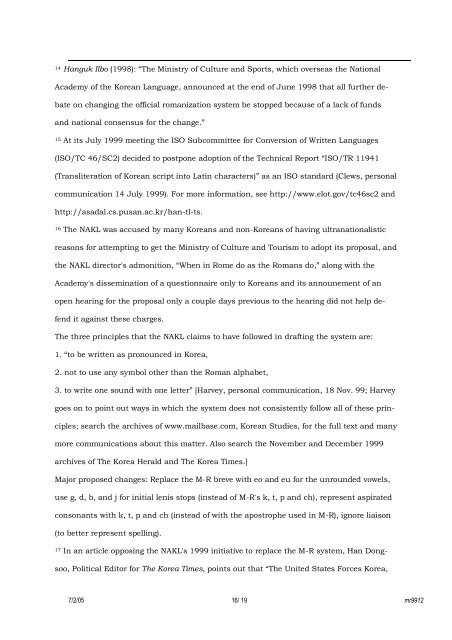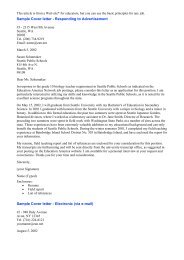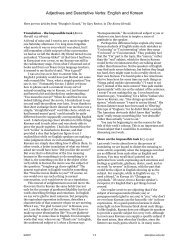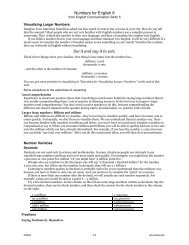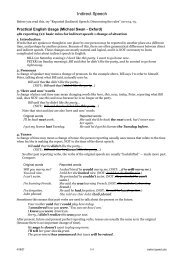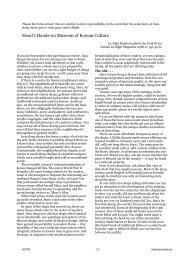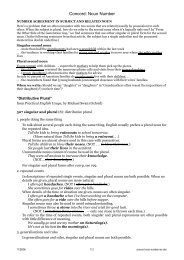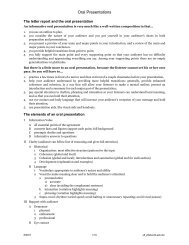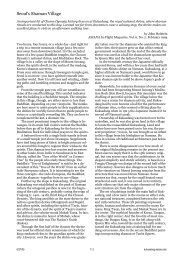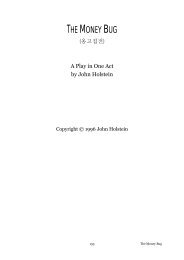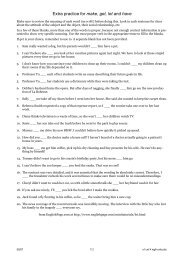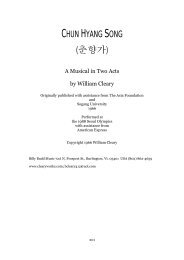The McCune-Reischauer Korean Romanization ... - Korea Mosaic
The McCune-Reischauer Korean Romanization ... - Korea Mosaic
The McCune-Reischauer Korean Romanization ... - Korea Mosaic
You also want an ePaper? Increase the reach of your titles
YUMPU automatically turns print PDFs into web optimized ePapers that Google loves.
14 Hanguk Ilbo (1998): “<strong>The</strong> Ministry of Culture and Sports, which overseas the National<br />
Academy of the <strong><strong>Korea</strong>n</strong> Language, announced at the end of June 1998 that all further debate<br />
on changing the official romanization system be stopped because of a lack of funds<br />
and national consensus for the change.”<br />
15 At its July 1999 meeting the ISO Subcommittee for Conversion of Written Languages<br />
(ISO/TC 46/SC2) decided to postpone adoption of the Technical Report “ISO/TR 11941<br />
(Transliteration of <strong><strong>Korea</strong>n</strong> script into Latin characters)” as an ISO standard (Clews, personal<br />
communication 14 July 1999). For more information, see http://www.elot.gov/tc46sc2 and<br />
http://asadal.cs.pusan.ac.kr/han-tl-ts.<br />
16 <strong>The</strong> NAKL was accused by many <strong><strong>Korea</strong>n</strong>s and non-<strong><strong>Korea</strong>n</strong>s of having ultranationalistic<br />
reasons for attempting to get the Ministry of Culture and Tourism to adopt its proposal, and<br />
the NAKL director's admonition, “When in Rome do as the Romans do,” along with the<br />
Academy's dissemination of a questionnaire only to <strong><strong>Korea</strong>n</strong>s and its announement of an<br />
open hearing for the proposal only a couple days previous to the hearing did not help defend<br />
it against these charges.<br />
<strong>The</strong> three principles that the NAKL claims to have followed in drafting the system are:<br />
1. “to be written as pronounced in <strong>Korea</strong>,<br />
2. not to use any symbol other than the Roman alphabet,<br />
3. to write one sound with one letter” [Harvey, personal communication, 18 Nov. 99; Harvey<br />
goes on to point out ways in which the system does not consistently follow all of these principles;<br />
search the archives of www.mailbase.com, <strong><strong>Korea</strong>n</strong> Studies, for the full text and many<br />
more communications about this matter. Also search the November and December 1999<br />
archives of <strong>The</strong> <strong>Korea</strong> Herald and <strong>The</strong> <strong>Korea</strong> Times.]<br />
Major proposed changes: Replace the M-R breve with eo and eu for the unrounded vowels,<br />
use g, d, b, and j for initial lenis stops (instead of M-R's k, t, p and ch), represent aspirated<br />
consonants with k, t, p and ch (instead of with the apostrophe used in M-R), ignore liaison<br />
(to better represent spelling).<br />
17 In an article opposing the NAKL's 1999 initiative to replace the M-R system, Han Dongsoo,<br />
Political Editor for <strong>The</strong> <strong>Korea</strong> Times, points out that “<strong>The</strong> United States Forces <strong>Korea</strong>,<br />
7/2/05 16/ 19 mr9912


